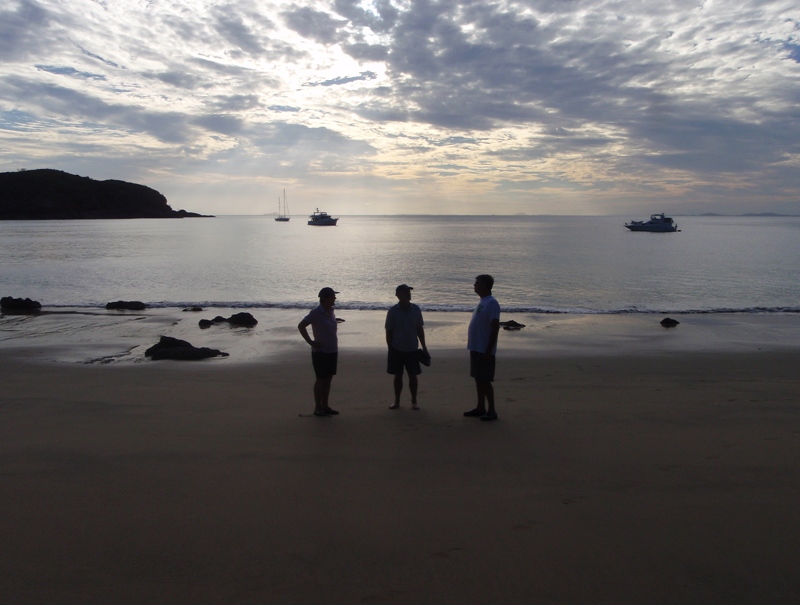Return to the Tropics - Hummocky Island, Queensland, Australia

Harmonie
Don and Anne Myers
Thu 6 May 2010 12:05
|
23:23.897S 151:09.142E
On April 28th, we motorsailed another 8 hours
in light winds to Hummocky Island. These are the same waters and basically
the same route sailed by Captain Cook on his first voyage north along the
east coast of Australia inside the Great Barrier Reef in the 1770's. The
fact that he and his crew safely sailed through this uncharted area despite the
thousands of obstacles that exist in the form of sand banks, coral reefs,
protruding rocks and huge tidal streams is impressive enough, but what really
amazes us is Captain Cook's ability to come up with a fresh name for
every cape, headland, point, bay, cove, strait, passage, creek, river, island,
islet, rock, beach, sand bank and reef he encountered. How is that
possible? We would run dry of new and imaginative names after the first
200 or so. Not so for Captain Cook. Although, assuming he
was the one who named Hummocky Island, you could argue that the
name isn't really all that imaginative since Hummocky Island
looks, well, hummocky. The same could be said for Thirsty Sound since its
name came as a result of Cook's inability to locate fresh water in the
area. And then there's Strong Tide Pass, also named for obvious
reasons. I guess we can forgive Captain Cook the
few mundane names he chose given the sheer number he spouted
forth as Endeavour sailed up the Australian coast. The man
must have been mentally exhausted by the time he sailed back into
waters filled with places already named by Europeans.
Picture 1 - The Shen Nang 1. On the way to
Hummocky Island, we passed the city of Gladstone (pronounced Gladstin in
Aussie-speak) and an array of anchored bulk carrier freighters waiting
outside the harbor entrance. A little further out from the rest of the
freighter pack was the Shen Nang 1 and its three companions - two tugboats and a
larger...not sure what kind of vessel it was. Anyway, the Shen Nang 1, a
Chinese coal carrier, is infamous for its April 3rd crash into part of the
Great Barrier Reef. Apparently, the crew decided to take a short cut
through the reef leaving the designated shipping lane behind. Not a
smart move. Three weeks, several miles of bashed marine park reef,
and millions of dollars spent on the recovery effort later, and the captain
and first mate landed in Australian court. The ship has been pushed
and towed hundreds of miles from the scene of its reef crash to just
outside Gladstone where we passed within a mile of it and its escorts.
Last we heard, it was headed to Brisbane where they hope to unload its coal
cargo and the remains of the 975 tons of oil it still has on board. All in
all, a very ugly scene and a big story in Australia.
Picture 2 - Cape Capricorn. So named by
Captain Cook because it sits almost directly on the Tropic of Capricorn (23.5
degrees south latitude). In other words, Cape
Capricorn officially marks a north-going vessel's entry into the
tropics. Or in our case, re-entry. Not that we ever felt like we
left the tropics this year...the Australian summer is plenty hot and sunny, even
in the higher, non-tropical latitudes.
Picture 3 - Storyteller with one of the hummocks of
Hummocky Island behind it.
Picture 4 - We landed the dinghy for a
quick walk along the Hummocky Island beach before sundown. That's
Sue, John and Don's silhouettes, with Harmonie, Storyteller and a local
Australian motor boat in the background. It was a lovely spot, but
the incessant rolling brought on by swell sneaking around the
northeast corner of the bay caused us to move on after only one
night. We are pretty hearty folk when it comes to sleeping in a
rocking boat, but when the motion causes us to roll in our bed like
hot dogs on one of those rotating grills found in convenience
stores, sports arenas and really bad airport food stands (who eats those hot
dogs anyway?), we generally decide it's time to move on.
Anne
|



